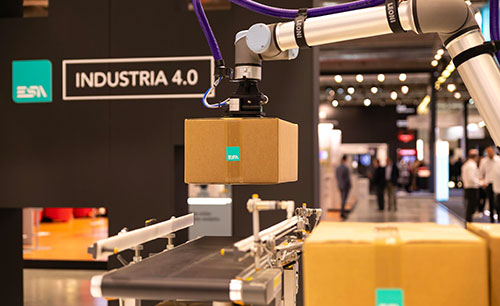What is the role of collaborative robots, or cobots, in Industry 4.0? In Smart Factory and IoT era, this new technology finds its perfect location. In fact, market researches foresee a significant increase in the sale of cobots over the next few years.
On this regards, recently ESA presented a solution for monitoring and controlling cobots. Read on to learn more.
Benefits of cobots for the industry
What are cobots? Collaborative robots designed to collaborate with human operators. While a traditional industrial robot is programmed to complete a specific and predefined task within a physical workspace, a cobot is conceived to interact and collaborate with humans within a shared workspace.
Such technology is perfectly in line with the principles of Industry 4.0, contributing to intelligent production in many ways. Specially:
- Interoperability and Internet of Things: Cobots are able to interact and work easily with other devices and systems, in any industrial environment.
- Big Data: Through their ability to collect data and transmit it to other systems, they promote the flow of large volumes of transparent information.
- Ease of usage: Thanks to their interactive interface (display, etc.), cobots are particularly intuitive and easy to use. They also facilitate decentralized, or horizontal, decisions.
- Productivity: Increasing the efficiency of processes, cobots allow to maximize the productivity of any industrial plant.
In light of these benefits, it’s clear why cobots in Industry 4.0 are a growing trend. The World Robotics Report 2017 of the International Federation of Robotics (IFR) forecasted an average increase of + 15% per year, for a total of 3 million operating robots by 2020. While according to the Collaborative Robots Market report, cobots market will reach $4.28 billion, with a compound annual growth rate of 56.94%.
ESA solution for cobots
For SPS Italia 2019, we created an application to monitor and control a UR series cobot, which displays the position of the robot on the three X, Y, Z axes in terms of absolute coordinates, relative angular coordinates and moving speed.
In this solution, the ESA HMI (or industrial PC) communicates with the control of the collaborative robot via Modbus TCP protocol, available in our SCADA Crew software. Both the address space of the registers and the supported Modbus function codes enable to access to all data and to the status and command registers available on the control.
Finally, we added command buttons to start/stop the robot and to put it in “service” mode. This mode is particularly useful for the manual control of the piece that comes to the operator with non-torque motors. In this way, the operator can move the piece freely, control it and then restore the start of the automatic cycle.
Discover all ESA solutions for Industry 4.0

